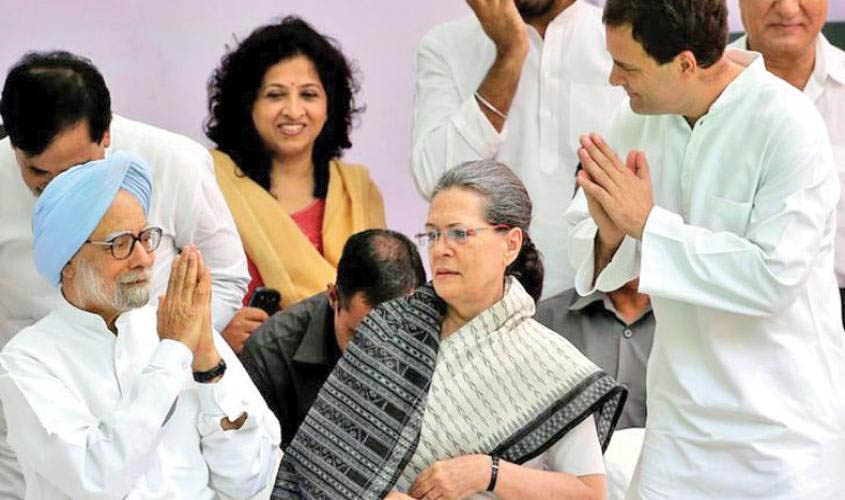All over the country, Narendra Modi’s series of victories in various elections and more recently in Delhi have triggered intense speculation regarding the necessity to forge unity amongst opposition ranks so as to curb his growing influence. However, unity at this juncture requires both sacrifice and comprehension of the ground situation. It has to be kept in mind that any kind of alliance among parties opposed to the BJP requires a well thought through strategy and categorical clarity on the projected leader who can take on the Prime Minister in the run-up to the 2019 Parliamentary polls. Otherwise, the Modi juggernaut would march forward with a clueless opposition conducting one experiment after the other to halt him.
Way back in 1971 when Indira Gandhi looked most vulnerable following the 1969 Congress split, her adversaries teamed up to form a Grand Alliance comprising the Bharatiya Jana Sangh, the Swatantra Party, the Socialist Party and the Congress (O). They had no agenda save their collective hatred for the then Prime Minister. Sensing the mood of the people and the contradictions in the alliance, Indira Gandhi shot back, Woh kehte hain ki Indira Hatao, Lekin mein kehti hoon ki Garibi Hatao (They say that removing Indira was their top objective, but eradicating poverty is my foremost priority). The rest is history and Indira Gandhi has been acknowledged as the greatest mass leader of the last century.
Initially in the late seventies, a coalition in the form of the Janata Party was partially successful post emergency. However, internal contradictions as well as the inability of Morarji Desai to receive acceptance as the leader of the ideological paradoxical formation resulted in the spectacular comeback of the Congress propelled by Indira’s popularity and Sanjay Gandhi’s pragmatic approach and Youth brigade.
Attempts at bringing together incompatible sleeping partners worked for less than a year for Vishwanath Pratap Singh who came to power riding on an anti-Congress wave in 1989, yet was unable to continue as the Prime Minister after the BJP led by L.K. Advani gave a clarion call for uniting Hindutva forces following the announcement of the Mandal Commission report implementation. Chandrashekhar’s government did not last too long either when the Congress decided to pull the rug from under his feet after two Haryana police personnel were caught spying at the 10 Janpath residence of former Prime Minister Rajiv Gandhi.
Thus to conclude that a coalition of parties, many of which have been contesting against each other would work to dislodge Modi is presumptuously premature. The primary question that arises: who would lead this proposed alliance? It is evident that no regional party would accept Rahul Gandhi’s leadership given the strong negative perception regarding his political understanding and capabilities.
The situation is different from what it was in July 2003 when during the Shimla Congress Conclave, Sonia Gandhi invited secular parties to join a coalition which she was willing to head against the then NDA government led by Atal Behari Vajpayee. The Congress had more than 110 MPs in Lok Sabha and was in power in nearly a dozen states. It had the status and the credentials to be the commander of an alliance and therefore in 2004 was able to wrest power when Vajpayee made the folly of going in for early elections prompted by an impatient Advani , a hopeful Pramod Mahajan and an insecure Chandrababu Naidu. Today, the Congress has 43 seats in the Lok Sabha and is losing hold over one state after the other. It has ceased to be the single most important political entity in the country ceding the space to the BJP which has emerged to occupy the pivotal position in Indian politics. Ironically, Sonia Gandhi’s own coterie played a role in both downsizing and ridiculing Rahul Gandhi who is viewed in political circles as the best insurance for Modi’s return in 2019.
Therefore, the Congress has to resign to the reality that it cannot have the leadership mantle in any future consortium and thus has to rise to the occasion by playing the facilitator. It would make viable sense to the prospective partners if the Congress helps in forging unity of the opposition and thereby relinquishes the command from the very beginning. Thereafter, the Congress High Command can assist the opposition to narrow down their choice to either the Bihar Chief Minister Nitish Kumar or the West Bengal Chief Minister Mamata Banerjee or for that matter any other mutually acceptable name as the campaign spearhead. The combined and pooled wisdom of the partners would have to reckon with both Modi’s appeal and guile and shall have to wait for him to commit any mistake.
Moreover, the secular formula which worked out in 2003, in all probability, may not be applicable in 2019 and unless there is a development and good governance programme backed by action and credibility, the alliance would find it very difficult to take off. The Congress and its associates must grasp and fathom the situation which shows that Modi would be unbeatable in the next round. Therefore, the long term strategy should be to cobble the coalition and prepare it to seize control in 2024. The Congress, in particular must register this political mileu. Between us.

